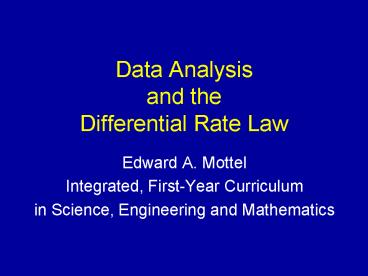Data Analysis and the Differential Rate Law - PowerPoint PPT Presentation
1 / 24
Title:
Data Analysis and the Differential Rate Law
Description:
in Science, Engineering and Mathematics. Please be sure you have a copy of ... What does time = mean? Time infinity is the point at which ... – PowerPoint PPT presentation
Number of Views:77
Avg rating:3.0/5.0
Title: Data Analysis and the Differential Rate Law
1
Data Analysisand theDifferential Rate Law
- Edward A. Mottel
- Integrated, First-Year Curriculum
- in Science, Engineering and Mathematics
2
- Please be sure you have a copy of
- Differential Rate Law and Data Analysis
- The Differential Rate Law Analysis Problem Set.
- If you dont know everyone at your table,
introduce yourself. - The Town Meeting today is 9th Period in the GM
Room (B-119)
3
Determination of theRate Constant and Order of a
Reaction
- This lecture identifies methods by which the
order of a chemical reaction and the rate
constant for the reaction can be determined. - The differential rate method is presented.
4
Methods To Determine theOrder of a Reaction
- Initial rate method
- Differential rate method
- Integrated rate law
- Linear integrated rate law method
- Non-linear integrated rate law method
5
Initial Rate Method
- Hold all but one of the concentrations of
reactants constant, and measure the initial rate
of reaction as a function of the reactant
concentration being varied.
6
Differential Rate Method
- Measure the rate of reaction at several times
during the course of the reaction and determine
the concentration at these points. - A ratio of values allows the determination of the
order of the reaction.
7
Decomposition of Nitrogen Dioxide at 400 K2
NO2(g) 2 NO(g) O2(g)
- The total pressure of the gaseous system will be
measured at several times. - These data will be used to determine
- the order of the reaction in terms of nitrogen
dioxide, and - the rate constant at 400 K.
8
Decomposition of Nitrogen Dioxide at 400 K2
NO2(g) 2 NO(g) O2(g)
Now what?
9
How does the slope relate to the amount of
reactant?
We need PNO2 at the various times
10
Decomposition of Nitrogen Dioxide at 400 K2
NO2(g) 2 NO(g) O2(g)
How does the pressure of NO2 relate to the total
pressure of the system?
Ptotal PNO2 PNO PO2
11
Decomposition of Nitrogen Dioxide at 400 K2
NO2(g) 2 NO(g) O2(g)
What does time mean?
Time infinity is the point at which the reaction
appears to have stopped (100 complete or
reached equilibrium).
12
Decomposition of Nitrogen Dioxide at 400 K2
NO2(g) 2 NO(g) O2(g)
Did this reaction go to completion?
If only NO2 was present at time 0, then what
total pressure would be expected at time infinity?
2 NO2(g) 2 NO(g) O2(g)
0
474
237
Since the final pressure was 708 torr, either the
reaction is almost complete or the original
sample wasnt 100 pure.
13
Decomposition of Nitrogen Dioxide at 400 K2
NO2(g) 2 NO(g) O2(g)
Assume the sample is 100 pure at time 0.
Looking at the balanced equation, what
relationship is there between PNO2 and PNO?
PNO2 PNO 474 torr
What relationship is there between PNO and PO2?
PO2 1/2 PNO
14
Decomposition of Nitrogen Dioxide at 400 K2
NO2(g) 2 NO(g) O2(g)
Assume the sample is 100 pure at time 0.
What is the pressure of each gas at 26 s?
Ptotal PNO2 PNO PO2
511 torr
PO2
37 torr
PO2 (511 - 474) torr
15
Decomposition of Nitrogen Dioxide at 400 K2
NO2(g) 2 NO(g) O2(g)
474
400
74
37
290
184
92
200
274
137
70
404
202
6
468
234
16
Nitrogen Dioxide Decomposition at 400 K
Determine the rate at each data point.
17
Determining theOrder of Reaction
At Point 1
rate1 k (PNO2,1)n
At Point 2
rate2 k (PNO2,2)n
18
Determining theOrder of Reaction
19
Determining theOrder of Reaction
20
Determining theOrder of Reaction
21
Determining theOrder of Reaction
Determine the order from the rates at various
pairs of data points.
22
Order of Reaction
- Corresponds to a specific mechanism
- Can only be determined experimentally
- Depends on a number of factors
- Reactants
- Solvent
- Other species present, including a catalyst
23
Determining the Rate Constant
24
(No Transcript)































